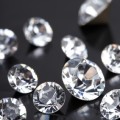What Is Moissanite?
Moissanite is a form of silicon carbide that is relatively rare in nature.

This material has hardness graded 9.5 on the Mohs scale – a rating that is very close to that of diamond, which is a 10 on the same scale.
In addition, moissanite looks very similar to diamond and is often used as its imitation.
Since naturally occurring moissanite is very rare, most of it is produced synthetically.
How Moissanite Is Different from Diamond
Although it resembles diamond, moissanite is actually very different in quite a few respects.
Here are some of the most salient differences between these two stones:
Hardness
Like diamond, moissanite is very hard. Its hardness is 9.5 on the Mohs scale, while diamond is 10. The durability of moissanite is one of the reasons it is likened to diamond.
Moissanite has more brilliance than diamond.
Moissanite is more brilliant and sparkly than a diamond with similar clarity, color, and cut. In addition, moissanite has the so-called “double refraction” property.
This means that if you look through the top or the side of a polished round moissanite, the facets on the opposite side of the stone will appear doubled. In diamonds, you shouldn’t be able to see such an effect.
Moissanite has more “fire”.
The so-called “fire” effect is another name for dispersion, which refers to how a stone breaks down light into spectral colors. When light enters moissanite, the fire produced is more intense than that in diamond.
So, if you hold a moissanite in front of your eye against a source of light, the flashes you will see should be bigger and more colorful than those you would observe in a diamond.
Moissanite weighs less than diamond.
Moissanite has lower density and specific gravity compared with pure diamond.
What this means is that if you compare the weight of a moissanite and diamond of the same size, the moissanite will be lighter.
Moissanite is much cheaper than diamond.
Moissanite costs a fraction of the price asked for a real diamond. For example, a moissanite can sell at 10-15% of the price of a diamond with similar clarity, color, cut, and size. H
However, while a low price tag can indicate that the stone is not a diamond, do not assume that you are being offered the real thing just because it is expensive – there are sellers that would be happy to offer you a fake stone at the price of a genuine diamond.
Moissanite has higher clarity than diamond, on average.
Most of the moissanite sold these days is created in a lab under controlled conditions that minimize internal flaws, and that’s why this stone usually has higher clarity than most diamonds.
While having few inclusions doesn’t necessarily mean that a stone is moissanite, if its price is unusually low to boot, this can at least be a signal that you are not looking at a real diamond.
Color
Here, diamond is the clear winner. Whereas the highest quality diamonds are colorless, there are no moissanites that can live up to this standard.
All moissanite available is colored in some way, no matter how slightly. The best moissanite color you will be able to find is white with visible yellow tints, but you won’t find pure white as in the best quality diamonds.
The Best Way to Identify Moissanite
The best way to tell whether a stone is a diamond or moissanite is to use a diamond tester or a moissanite tester.
Diamond testers detect whether a stone is a real diamond by analyzing how the material conducts heat or electricity.
You should keep in mind that devices that use heat won’t be able to distinguish moissanite since its heat conductivity is very close to that of diamond.
Electronic diamond testers, on the other hand, will be able to tell the difference.
However, such a device may only be able to show you that the stone is not diamond, but not whether it is moissanite.
Many diamond testers come with the option of identifying moissanite as well, but if your tool doesn’t have this capability, you won’t be able to tell for sure.
Moissanite testers are specifically designed to identify whether a stone is moissanite. They operate on the same principle as electronic diamond testers do, i.e., by inducing electric current that passes through the stone and measuring how it conducts electricity.
Check out moissanite testers here.
Should You Buy Moissanite as an Alternative to Diamond?
So why would you buy moissanite?
First of all, if you cannot afford a real diamond, moissanite is so cheap in comparison that it would likely be within reach, and it comes quite close to diamond in terms of durability.
In addition, this stone’s clarity is usually very high, and a diamond of a comparable grade will likely cost ten times as much.
Moissanite has more brilliance, but just keep in mind that its highly intense sparkle makes it obvious that it is not a diamond (for those who can tell, at least).
However, the biggest downside to moissanite is that its color puts it in the same grade as lower quality diamonds that have a visible yellow tint.
So, if you’ve decided to give moissanite a try anyway, just make sure you don’t have it set in a white setting.
If you pick silver or white gold, for example, the yellowish tints will stand out even more. Instead, you can choose yellow gold, which will make moissanite’s not-so-perfect color less noticeable.














